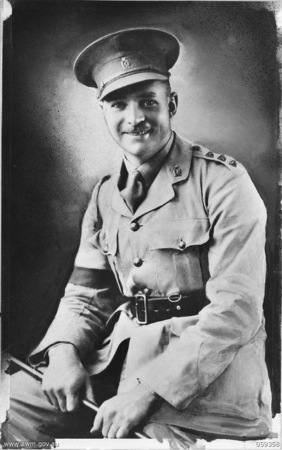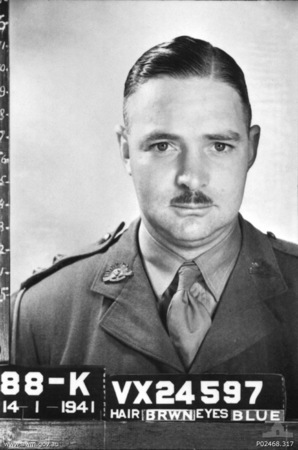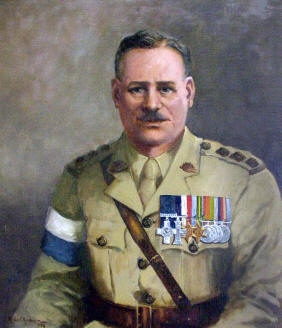
Photo
courtesy of Australian War Memorial.
ID 059358

Paybook
photograph, taken on enlistment, of VX24597 Captain Lionel Colin
Matthews GC MC, 8th Division Signals, Australian Corps of Signals
Photo courtesy of Australian War Memorial.
ID P02468.317

After training as a signalman in the Citizen Naval Forces, Matthews enlisted in the Militia in April 1939. Posted to the 3rd Division Signals, he was commissioned lieutenant in January 1940. On 10 June he transferred to the Australian Imperial Force and in February 1941 sailed for Singapore with the 8th Division Signals. Sporting a clipped moustache, he was nicknamed 'The Duke' because of his resemblance to the Duke of Gloucester. Matthews was athletically built, stood 6 ft 1 in. (185 cm) tall, had a ready smile, and liked to dress well. As signals officer, 27th Brigade, he maintained cable communications while under fire at Gemas, Malaya, and on Singapore (January-February 1942), and won the Military Cross. In January 1942 he was promoted captain. After Singapore fell on 15 February, he was interned in Changi prison.
In July 1942 the Japanese shipped 'B' Force, which comprised 1496 Australians (including Matthews), to Sandakan in British North Borneo. Soon after his arrival he was largely responsible for setting up an elaborate intelligence organization. Contact was made with Dr J. P. Taylor, an Australian in charge of the nearby government hospital, and with European internees on Berhala Island. Matthews and his second-in-command Lieutenant R. G. Wells contacted a number of Asians—some of them were Chinese and others belonged to the British North Borneo Constabulary—who gave them a revolver, maps, information, medical supplies and parts for a wireless receiver.
By September 1942 the intelligence network had been consolidated and extended. All information was reported to Matthews and collated for future use. He got in touch with Filipino guerrillas operating in the Sulu Archipelago and enabled parties of Australian prisoners to escape. In January 1943, when the Japanese transferred the civilian internees to Kuching, unofficial control of the armed constabulary passed to Matthews. He developed a contingency plan to overthrow the Japanese in the event of an allied landing in Borneo. At his direction, work began on the construction of a wireless transmitter.
In July 1943 four Chinese members of the organization were betrayed to the Japanese. Under torture, they admitted supplying radio parts. The Japanese arrested Matthews, Wells, Taylor and those who had helped them. The suspects were interrogated, beaten, tortured and deprived of food before being taken to Kuching. Matthews was sentenced to death, as were two members of the constabulary and six other Asians. Declining a blindfold, he was executed by a firing-squad on 2 March 1944 at Kuching and buried there. In 1946 his body was exhumed and interred in the Labuan war cemetery.
Matthews had encouraged his fellow accused throughout their ordeal.
Although he knew the consequences, he refused to implicate or endanger
the lives of his associates. Described as a 'prince among men', he was
posthumously awarded the George Cross (1947). His wife and son survived
him. Robert Anderson's portrait of Matthews is held by the School of
Signals, Simpson Barracks, Melbourne. Matthews' brother Geofrey served
in the army in World War II and was awarded the Distinguished Service
Order.
Details courtesy of ABConline